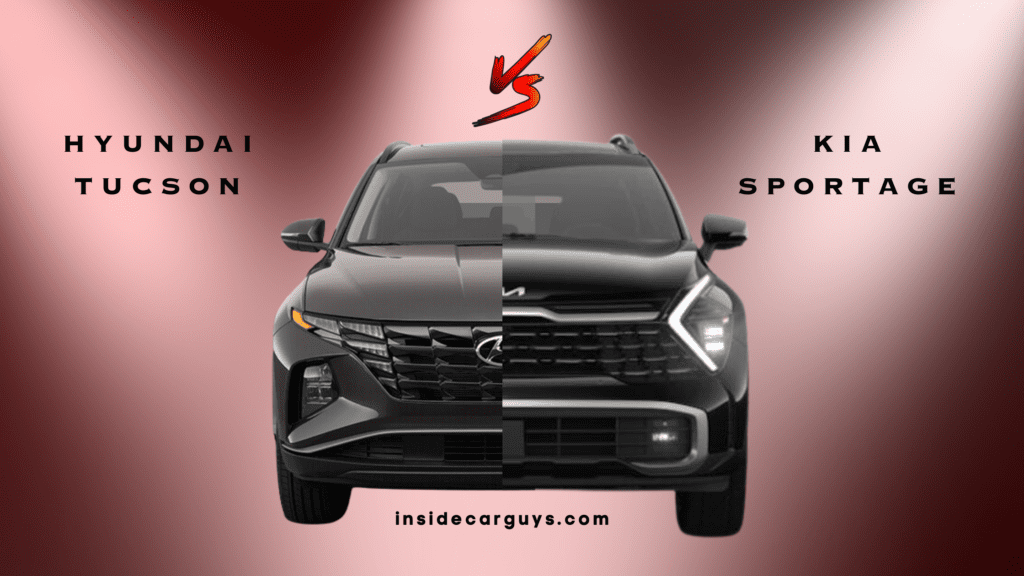In today’s competitive automotive landscape, discerning buyers are always on the lookout for the ideal blend of style, performance, and value. The Hyundai Tucson and Kia Sportage stand out as two compelling choices in the compact SUV segment, each with its own set of strengths and unique features.
In this comparison, we dive deep into the similarities and differences between these two popular South Korean models, enabling you to make an informed decision when considering your next vehicle purchase.
Exterior Design:
The Hyundai Tucson boasts a sleek and sophisticated exterior design. Its distinctive cascading grille, sharp LED headlights, and angular lines create a futuristic look, while the muscular wheel arches and aerodynamic profile give it an aggressive stance. The Tucson’s design language is a testament to Hyundai’s focus on innovation and style.
The Kia Sportage also sports an eye-catching design. The tiger-nose grille, the signature of Kia vehicles, is complemented by the dynamic LED headlights and bold front fascia. The Sportage’s side profile is characterized by smooth curves and a sloping roofline, while the rear features a stylish spoiler and sleek LED taillights. The design emphasizes the Sportage’s athletic and modern appeal.
Interior Design:
Inside the Tucson, you’ll find a well-crafted and spacious cabin. The minimalist dashboard design features a digital instrument cluster and a large infotainment touchscreen that seamlessly integrates with the rest of the layout. The use of high-quality materials and soft-touch surfaces gives the Tucson’s interior a luxurious feel, while the ambient lighting adds a touch of elegance.
The Sportage’s interior is equally impressive, featuring a clean and user-friendly layout. The large touchscreen infotainment system is easy to navigate, and the digital instrument cluster provides clear and crisp information. The cabin boasts a mix of soft-touch materials and tasteful accents, ensuring a comfortable and stylish driving experience.
Seating:
The Tucson offers comfortable seating for up to five passengers. Both the front and rear seats provide ample legroom and headroom, making long drives more enjoyable. The seats are upholstered in either durable cloth or plush leather, depending on the trim level. Additionally, heated and ventilated front seats and a heated steering wheel are available for added comfort.
The Sportage also has seating for five passengers, with a similarly spacious cabin. The seats are supportive and comfortable, with available leather upholstery for a more luxurious feel. Heated and ventilated front seats, as well as a heated steering wheel, are available options to enhance passenger comfort.
Storage:
The Tucson offers a generous amount of storage space for an SUV in its class. With the rear seats up, you’ll have 38.7 cubic feet of cargo space, which expands to 74.8 cubic feet when the seats are folded down. The Tucson also features clever storage solutions such as underfloor compartments and a hands-free power liftgate for easy loading and unloading.
The Sportage provides slightly less cargo space than the Tucson, with 31.0 cubic feet behind the rear seats and 62.8 cubic feet with the seats folded down. However, it also features handy storage solutions like a dual-level cargo floor and a power liftgate for easy access.
Performance:
The 2023 Tucson is available with a choice of three powertrains: a 2.5-liter four-cylinder engine producing 187 horsepower, a 1.6-liter turbocharged engine with 226 horsepower in the hybrid model, and a 1.6-liter plug-in hybrid engine with a combined system output of 261 horsepower.
All engines are mated to an eight-speed automatic transmission, providing smooth shifts and responsive performance. The Tucson is available in both front-wheel drive (FWD) and all-wheel drive (AWD) configurations, depending on your driving preferences.
The Sportage offers two engine options: a 2.4-liter four-cylinder engine producing 181 horsepower and a 2.0-liter turbocharged engine delivering 240 horsepower. Both engines are paired with a six-speed automatic transmission. Like the Tucson, the Sportage comes in FWD and AWD configurations, catering to various driving needs.
Fuel Efficiency:
The Tucson’s fuel efficiency varies depending on the powertrain. The base 2.5-liter engine has an EPA-estimated rating of 26 mpg city and 33 mpg highway (FWD) and 24 mpg city and 29 mpg highway (AWD). The hybrid model delivers an impressive 38 mpg combined, while the plug-in hybrid offers an all-electric range of 33 miles and a combined rating of 80 MPGe.
The Sportage’s fuel efficiency is slightly lower compared to the Tucson. The base 2.4-liter engine has an EPA-estimated rating of 23 mpg city and 30 mpg highway (FWD) and 22 mpg city and 26 mpg highway (AWD). The more powerful 2.0-liter turbocharged engine offers 20 mpg city and 28 mpg highway (FWD) and 19 mpg city and 24 mpg highway (AWD).
Safety:
The Hyundai Tucson comes with an array of standard safety features, including forward collision warning, automatic emergency braking, lane-keeping assist, and driver attention warning. Optional safety features include blind-spot monitoring, rear cross-traffic alert, adaptive cruise control, and a surround-view camera system.
The Kia Sportage also prioritizes safety, with standard features such as forward collision warning, automatic emergency braking, lane departure warning, and lane-keeping assist. Available safety features include blind-spot monitoring, rear cross-traffic alert, adaptive cruise control, and a surround-view camera system.
Trim Levels:
The Tucson is available in several trim levels: SE, SEL, N Line, Limited, Hybrid Blue, Hybrid SEL Convenience, Hybrid Limited, Plug-in Hybrid SEL Convenience, and Plug-in Hybrid Limited. Each trim offers varying levels of features and amenities, catering to different buyer preferences and budgets.
The Sportage is offered in four main trim levels: LX, EX, EX Premium, and SX Turbo. Each trim level comes with different features and options, allowing buyers to customize their vehicle to their liking.
Pricing:
The base Hyundai Tucson SE starts at an MSRP of $25,500, while the range-topping Plug-in Hybrid Limited trim begins at $42,000. The various trim levels and powertrain options allow buyers to find a Tucson that fits their budget and requirements.
The base Kia Sportage LX starts at an MSRP of $24,090, and the top-of-the-line SX Turbo trim starts at $34,770. Similar to the Tucson, the Sportage offers a range of prices and features to cater to different buyer preferences.
Key Differences
While the Hyundai Tucson and Kia Sportage have several similarities, there are some key differences that set them apart in the compact SUV segment. Here, we highlight the most significant differences between these two vehicles.
Exterior Design:
While both vehicles feature attractive and modern designs, they each have their own unique styling elements. The Hyundai Tucson showcases a futuristic look with its cascading grille, sharp LED headlights, and angular lines, while the Kia Sportage highlights its athletic appeal through the tiger-nose grille, dynamic LED headlights, and smooth curves.
Cargo Space:
The Tucson offers more cargo space compared to the Sportage, with 38.7 cubic feet behind the rear seats and 74.8 cubic feet with the seats folded down. The Sportage provides less space, with 31.0 cubic feet behind the rear seats and 62.8 cubic feet when the seats are folded down.
Powertrain Options:
The Tucson comes with a more diverse range of powertrain options, including a standard 2.5-liter engine, a 1.6-liter hybrid engine, and a 1.6-liter plug-in hybrid engine. The Sportage, on the other hand, offers two engine options: a 2.4-liter engine and a 2.0-liter turbocharged engine.
Fuel Efficiency:
The Tucson has the edge in terms of fuel efficiency, particularly with its hybrid and plug-in hybrid models. The base Tucson achieves an EPA-estimated 26 mpg city and 33 mpg highway (FWD), while the hybrid model delivers a remarkable 38 mpg combined. The Sportage’s fuel efficiency is slightly lower, with the base model offering 23 mpg city and 30 mpg highway (FWD).
Trim Levels:
The Tucson is available in a wider variety of trim levels compared to the Sportage. With nine trims to choose from, including hybrid and plug-in hybrid options, buyers have more choices to suit their preferences and budgets. The Sportage, on the other hand, offers four main trim levels.
Pricing:
The base Hyundai Tucson SE starts at an MSRP of $25,500, while the base Kia Sportage LX begins at $24,090. Although the starting prices are relatively close, the Tucson’s range-topping Plug-in Hybrid Limited trim is priced higher, starting at $42,000, compared to the Sportage’s top-of-the-line SX Turbo trim, which starts at $34,770.
Final Thoughts:
After thoroughly comparing the 2023 Hyundai Tucson and Kia Sportage, it’s clear that both vehicles excel in various aspects, making them top contenders in the compact SUV market. While the Tucson stands out with its futuristic design, diverse powertrain options, and impressive fuel efficiency, the Sportage boasts a slightly lower starting price and a distinctive athletic appeal.
Ultimately, your choice will depend on your preferences, priorities, and budget. Regardless of which model you select, you can be confident that both the Tucson and Sportage deliver a well-rounded driving experience backed by the latest technology and safety features.
Features Breakdown:
Hyundai Tucson:
- Exterior Design:
- Futuristic and sophisticated design
- Cascading grille and sharp LED headlights
- Angular lines and muscular wheel arches
- Interior Design:
- Spacious and minimalist cabin
- Digital instrument cluster and large infotainment touchscreen
- High-quality materials and ambient lighting
- Seating and Storage:
- Comfortable seating for up to five passengers
- 38.7 cubic feet of cargo space (rear seats up) and 74.8 cubic feet (rear seats folded down)
- Underfloor compartments and hands-free power liftgate
- Performance and Fuel Efficiency:
- Three powertrain options: 2.5L, 1.6L hybrid, and 1.6L plug-in hybrid
- Eight-speed automatic transmission
- FWD and AWD configurations available
- Impressive fuel efficiency, with the hybrid model delivering 38 mpg combined
- Safety Features:
- Standard features include forward collision warning, automatic emergency braking, and lane-keeping assist
- Optional features such as blind-spot monitoring, rear cross-traffic alert, and adaptive cruise control
- Trim Levels and Pricing:
- Nine trim levels, including hybrid and plug-in hybrid options
- Base SE trim starts at $25,500, with the range-topping Plug-in Hybrid Limited starting at $42,000
Kia Sportage:
- Exterior Design:
- Eye-catching and athletic design
- Tiger-nose grille and dynamic LED headlights
- Smooth curves and sloping roofline
- Interior Design:
- Clean and user-friendly layout
- Large touchscreen infotainment system and digital instrument cluster
- Mix of soft-touch materials and tasteful accents
- Seating and Storage:
- Comfortable seating for up to five passengers
- 31.0 cubic feet of cargo space (rear seats up) and 62.8 cubic feet (rear seats folded down)
- Dual-level cargo floor and power liftgate
- Performance and Fuel Efficiency:
- Two engine options: 2.4L and 2.0L turbocharged
- Six-speed automatic transmission
- FWD and AWD configurations available
- Base model offers 23 mpg city and 30 mpg highway (FWD)
- Safety Features:
- Standard features include forward collision warning, automatic emergency braking, and lane departure warning
- Optional features such as blind-spot monitoring, rear cross-traffic alert, and adaptive cruise control
- Trim Levels and Pricing:
- Four main trim levels: LX, EX, EX Premium, and SX Turbo
- Base LX trim starts at $24,090, with the top-of-the-line SX Turbo starting at $34,770





